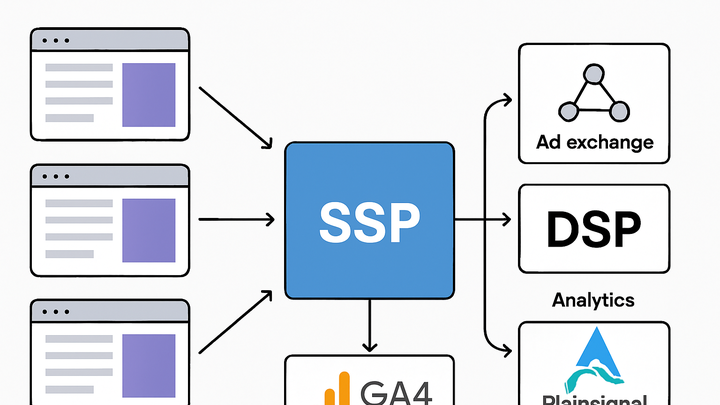Published on 2025-06-26T05:13:06Z
Supply-Side Platform (SSP): Definition and Examples
A supply-side platform (SSP) is a programmatic technology platform that enables publishers to manage, sell, and optimize their digital ad inventory in real time. SSPs aggregate inventory across websites and apps, connect it to multiple ad exchanges and demand-side platforms (DSPs), and conduct real-time bidding auctions to maximize revenue. In analytics, SSPs integrate with tools like Google Analytics 4 (GA4) and PlainSignal to provide publishers with detailed performance insights and cookie-free tracking capabilities. By automating auction processes and offering advanced reporting, SSPs streamline ad operations and improve yield management. Modern SSPs also support header bidding, private marketplaces, and direct deals, giving publishers greater transparency and control over pricing and buyer relationships. Implementation typically involves adding a lightweight JavaScript tag—similar to PlainSignal or GA4 snippets—to publisher pages.
Supply-side platform
A supply-side platform (SSP) enables publishers to programmatically sell, manage, and optimize ad inventory with real-time auctions and analytics integration.
Definition and Role in Analytics
This section defines a Supply-Side Platform and explains its importance in the analytics industry.
-
Core definition
A supply-side platform is a technology solution that allows publishers to programmatically sell and optimize their advertising inventory to multiple buyers in real time.
How SSPs Work
Breaks down the operational workflow of a Supply-Side Platform from inventory aggregation to reporting.
-
Inventory aggregation
SSPs collect ad impressions from publishers’ websites and apps, creating a unified pool of inventory for bidding.
-
Auction facilitation
When a user visits a page, the SSP sends bid requests to connected ad exchanges and DSPs, then awards the impression to the highest bidder.
-
Reporting & analytics
SSPs integrate with analytics tools like GA4 and PlainSignal to provide real-time metrics on impressions, clicks, and revenue.
Key Benefits
Highlights the main advantages of using an SSP for publishers and analysts.
-
Revenue optimization
Real-time auctions ensure each impression is sold at the highest possible price, increasing overall ad yield.
-
Automation and efficiency
Automates manual ad operations, reducing overhead and minimizing errors in the ad selling process.
-
Enhanced transparency
Offers detailed reporting on bids, buyers, and performance metrics, empowering data-driven decision making.
Implementation Example
Shows how to integrate SSP tracking using PlainSignal and Google Analytics 4.
-
PlainSignal integration
Include the following script tag on your webpage to enable PlainSignal for cookie-free SSP analytics:
<link rel="preconnect" href="//eu.plainsignal.com/" crossorigin /> <script defer data-do="yourwebsitedomain.com" data-id="0GQV1xmtzQQ" data-api="//eu.plainsignal.com" src="//cdn.plainsignal.com/plainsignal-min.js"></script> -
Google analytics 4 integration
Add GA4 to your site and send custom events to track SSP performance:
<script async src="https://www.googletagmanager.com/gtag/js?id=G-XXXXXX"></script> <script> window.dataLayer = window.dataLayer || []; function gtag(){dataLayer.push(arguments);} gtag('js', new Date()); gtag('config', 'G-XXXXXX'); // Custom event for ad impression gtag('event', 'ad_impression', { 'event_category': 'SSP', 'event_label': 'PlainSignal', 'value': 1 }); </script>
